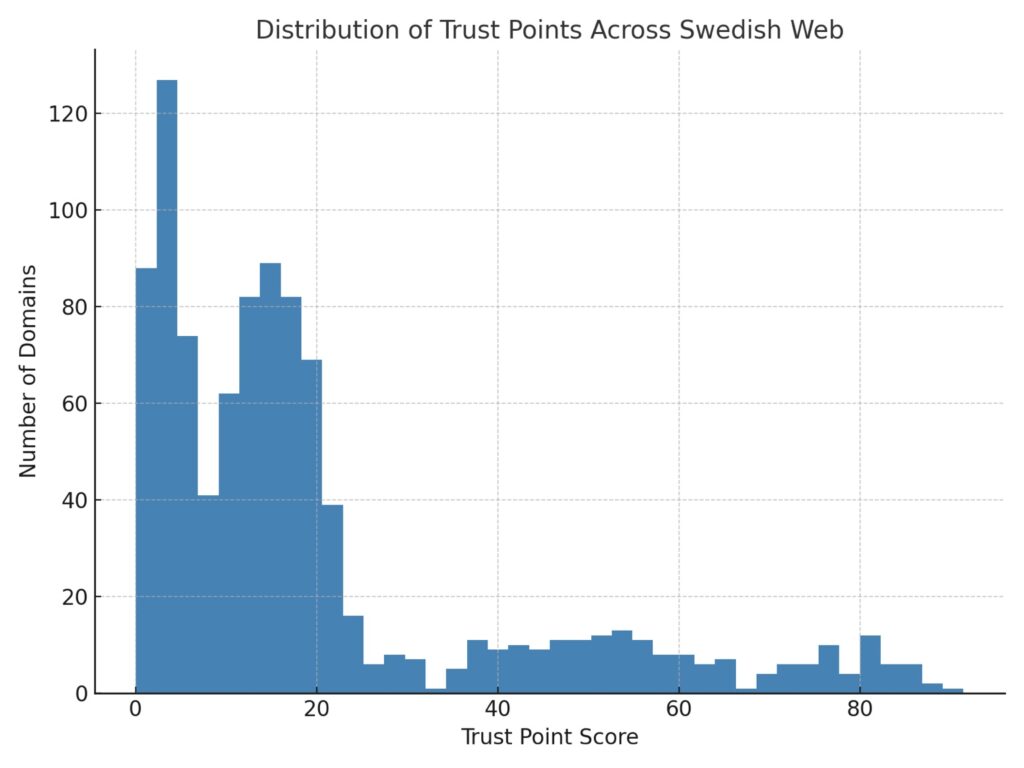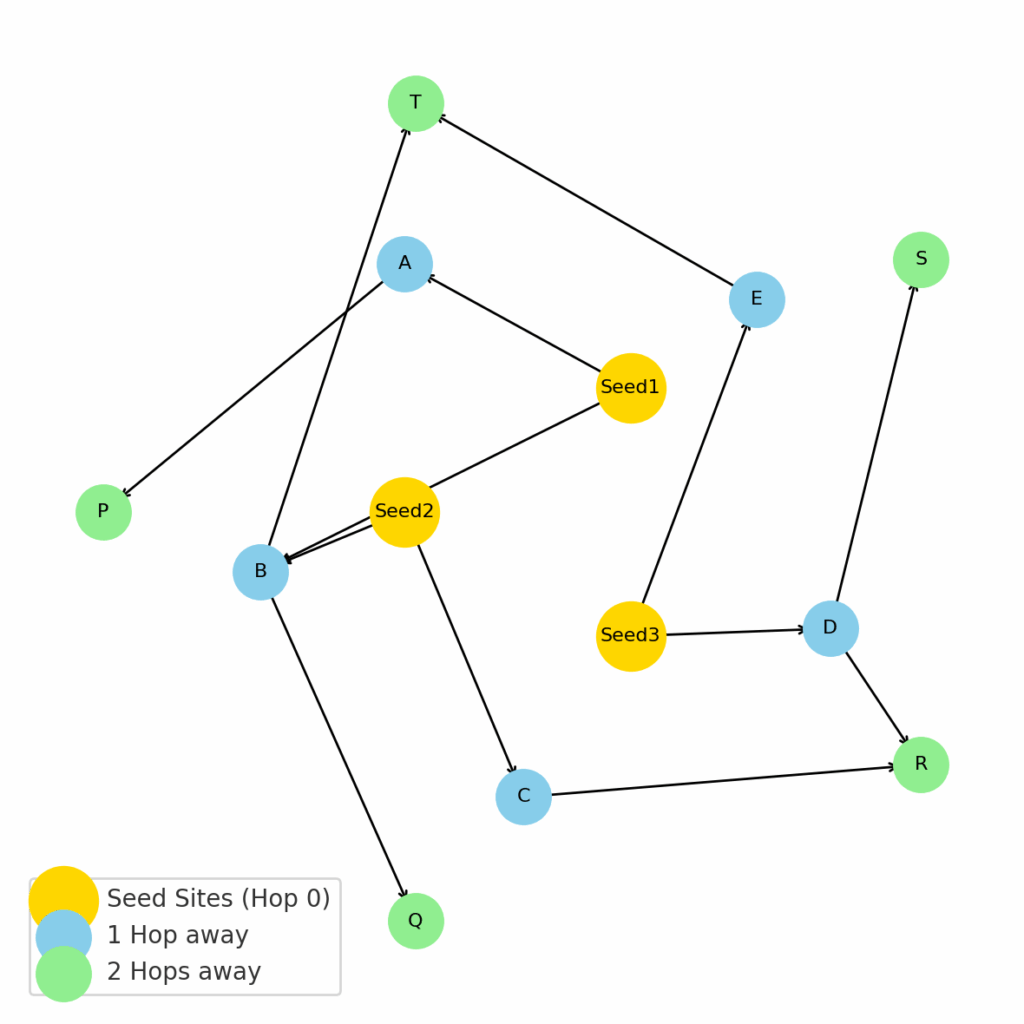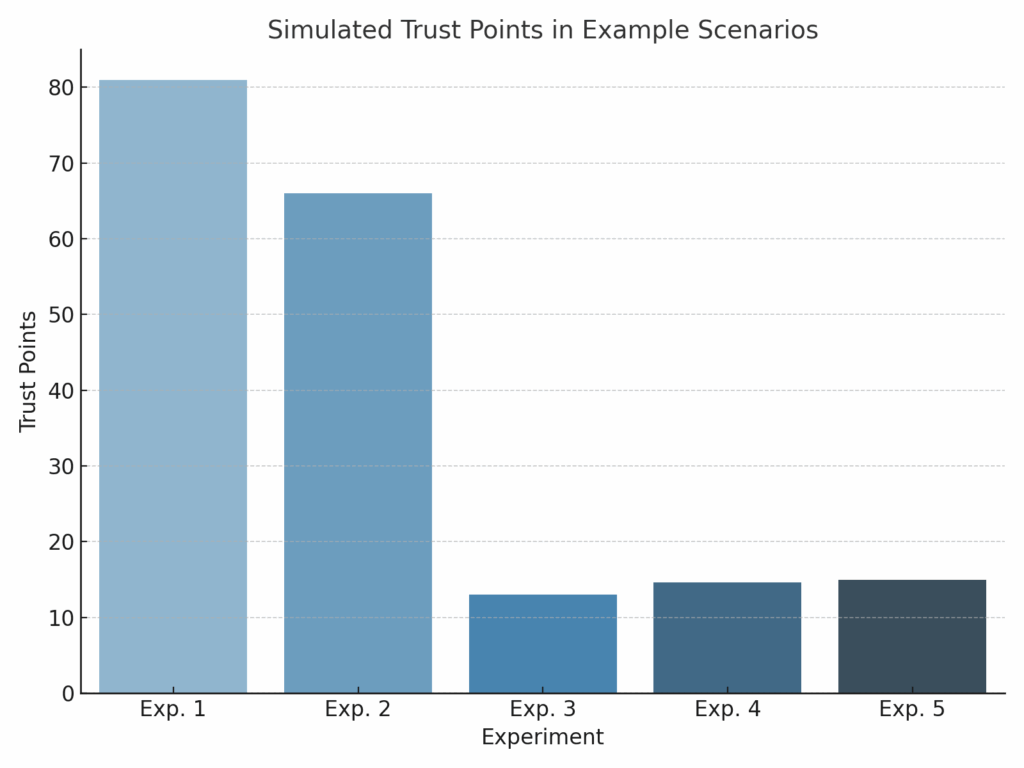This article is a practitioner-friendly summary of the research paper with the same title, including the first published list of high-confidence seed site candidates (S0) for Sweden.
For the full research paper: https://www.academia.edu/144984703/TrustRank_and_Seed_Sites_Modeling_Backlink_Value_for_Web_Trust_Propagation_in_a_Google_Like_Ranking_System
Why this research matters for SEO
For years SEOs have talked about “authority” and “trust”, but most tools still boil it down to a single number: Domain Authority, Domain Rating, Trust Flow, and so on. We know these scores are inspired by ideas like PageRank and TrustRank, but it has been hard to answer a very practical question:
Which backlinks actually move trust through the web graph – and how much are they worth?
At IncRev SEO Research Community, we built a concrete model to explore this question on the Swedish web (.se, .nu). We also publish something that, to our knowledge, has never been made public before:
A documented list of high-confidence “seed site” candidates for Sweden (S0) – the sites most likely to sit at the very core of a Google-like trust graph.
You’ll find the full table in the appendix below.
Instead of treating authority as a black box, we model how trust can propagate from these seeds through backlinks, and we measure how “close” a given site is to Sweden’s most trusted web properties.
What is a seed site?
In classic TrustRank, human reviewers select a small set of sites that are:
- very hard to spam
- clearly authoritative
- well connected to the rest of the web
From these seed sites, trust is pushed outwards along the link graph. The closer you are (in links and hops) to the seeds, the more trusted you are. Far away = less trusted, possibly spammy.
In our work we adopt this idea but flip the focus:
- Instead of using trust mainly to demote spam,
- we use it to measure and explain positive trust flow – how trust spreads from a core of Swedish authorities out to the rest of the .se / .nu ecosystem.
For Sweden, this means that domains like:
- government sites (e.g. regeringen.se, riksdagen.se, skatteverket.se)
- national public services (e.g. folkhalsomyndigheten.se, polisen.se, trafikverket.se)
- major universities (uu.se, kth.se, lu.se, su.se, etc.)
- national news media (svt.se, dn.se, aftonbladet.se, svd.se, di.se, gp.se, sydsvenskan.se)
form a trusted core. These are our S0 candidate seed sites, documented in the appendix.
How we modeled trust on the Swedish web (without the maths)
1. Start with a handpicked S0 seed set
We manually selected a few dozen Swedish sites that are:
- universally recognized as trustworthy
- unlikely to host spam
- spread across government, education, news, and key institutions
Each S0 site is treated as if a Google-like system had flagged it as “very safe and very important”. In the model, they start with a high amount of Trust Points (TP).
Think of Trust Points as a numerical way to answer:
“If Google built a trust graph for Sweden, who would be sitting in the front row?”
2. Let the data reveal secondary seeds (S1)
From there, we ask: Which sites do these seeds tend to link to?
Using Ahrefs data we:
- look at all Swedish domains that receive backlinks from S0 sites
- mark any domain that is linked by at least 5% of the seeds as an S1 site
These S1s are not manually chosen – they emerge from the link data. They are one step further out, but still heavily endorsed by the core.
Two interesting S1 examples:
- orientering.se – the Swedish orienteering federation, linked from multiple municipalities and public-sector sites
- borsvarlden.com – a financial news/aggregator site, linked from several major news outlets
These sites become trust distributors in their niches: sports, finance, etc.
3. Build a Swedish trust graph
Next, we construct a link graph focusing on:
- .se and .nu domains (local ecosystem)
- backlinks and outbound links for S0 and S1 sites, and their neighbors
- up to three hops away from the seeds
We do not attempt to model the entire web – only the Swedish portion that is realistically relevant for Swedish SEO.
Important constraints to keep it realistic and scalable:
- limit how deep we walk (max 3 hops from a seed)
- limit how many backlinks per site we include (Top-N by Ahrefs DR)
- filter out very weak domains (e.g. very low DR, likely spam)
This mirrors how a search engine might focus its attention: important nodes and the strongest connections.
4. Let trust fade with distance and link volume
Without going into formulas, the model is based on two intuitive principles:
- Distance matters
- each hop away from a seed reduces the trust that can reach you
- being 1 hop away (linked directly from svt.se or regeringen.se) is far better than 3 hops away via several intermediaries
- Link dilution matters
- if a site links to very many different domains, each individual link carries less endorsement
- if it links more sparingly, each link is stronger
On top of this, we:
- heavily discount nofollow links
- reward multiple independent paths from different seeds, but with diminishing returns (your second and third trusted links still help, but not as much as the first)
The outcome for any domain is a Trust Point score that reflects:
How close are you to Sweden’s most trusted sites
– and how strong are the paths that connect you?
What we found: trust hubs and distance from the core
Hidden hubs: S1 trust distributors
The S1 discovery process surfaced domains that might not be famous nationally, but are structurally important:
- orientering.se
- linked from several S0 sites in the public sector
- passes trust to local sports clubs and niche sites via its outbound links
- result: even a small local club can end up reasonably close to the trusted core if it’s linked from the federation
- borsvarlden.com
- linked from respected news outlets
- passes trust to financial blogs and partners it links to
- result: a finance site with a backlink from borsvarlden.com can “jump closer” to the trusted core
In both cases, getting one good link from an S1 site can be worth much more than dozens of random links from low-trust sites.
Clients: from far out to almost seed-level
When we applied the model to real client domains (anonymized in the research paper), we saw clear patterns:
- A client with:
- one direct link from a government site (S0), and
- one or two links from S1 hubs
ended up with a Trust Point score close to the S0 seeds themselves. In the trust graph, they were basically sitting just one or two steps away from the core.
- A client with only
- three-hop routes from weak sites and no S0/S1 connections
had a very low score and sat far out on the fringe of the graph.
This quantifies something SEOs feel intuitively:
A few deep, high-trust connections matter more than a pile of shallow, low-trust links.
Diagrams and tables we use in the article
On the IncRev SEO Research page, we recommend including simplified versions of these visuals:
1. Flowcharts and Calculation Example: To visualize the trust propagation process, consider the diagram below. Figure 1 shows a simple link graph with two S0 seeds (A and B), one S1 intermediary (X), and a target site. Seed A links to Site X, and Site X links to the target; Seed B links directly to the target. We annotate Seeds with their base TP and S1 with its base TP. In this scenario, trust flows from A to the target in 2 hops (A→X→Target), and from B to the target in 1 hop.
Figure 1: Example of trust propagation in a small web graph. Seed A (TP=100) passes trust through Site X (an S1 site, base TP=50) to reach the Target Site in two hops, while Seed B (TP=100) links directly (one hop) to the Target. In this configuration, Seed B provides a stronger trust contribution to the Target due to the shorter distance and fewer outlinks, whereas the path through Seed A is longer and thus more attenuated (especially if A had many outlinks).
2. Trust Point distribution (histogram)
What it shows:
A histogram of Trust Point scores for tens of thousands of Swedish domains.
What you see:
- a long tail of domains with close to 0 trust
- a small minority with high scores (seeds and sites sitting near them)
This supports the idea that the Swedish web has a dense trusted core and a very large low-trust periphery.

- Seed influence zones (concept diagram)

A simple graph where:
- S0 seeds are in the center
- one-hop neighbors (linked directly) form a “blue ring”
- two-hop neighbors form a “green ring”
The further away from the center, the lighter/greyer the nodes and the lower their Trust Points.
SEO takeaway: if your site lives in the blue or green ring, you’re in the “trusted neighborhood”. Beyond that, you’re in the grey zone.
4. Trust model comparison table
| Feature | TrustRank (2004) | PageRank (1998) | Our Trust Point Model |
| Starts from Seed Set | ✅ | ❌ | ✅ |
| Propagates Trust | ✅ | ❌ (propagates rank) | ✅ |
| Penalizes Nofollow | ❌ | ❌ | ✅ (75% penalty) |
| Multi-path Aggregation | ❌ | ❌ | ✅ |
| Topic Sensitivity | ✅ (in variants) | ❌ | ❌ (planned) |
| Hop-limited Propagation | Implicit | ❌ | ✅ (3 hops) |
| Outlink-aware Decay | Equal split | Equal split | Exponential 5% per outlink |
A compact table comparing:
- PageRank
- classic TrustRank
- the Trust Point model
On dimensions such as:
- starts from a seed set or not
- focuses on importance vs trust
- spam demotion vs trust promotion
- whether it accounts for nofollow, hop limits, multi-path effects
This helps practitioners understand that modern SEO metrics are closer to distance-from-seeds than pure PageRank popularity.
5. Example scenario chart

A small visual (or table) showing five hypothetical link scenarios, e.g.:
- One direct link from a government S0 site
- One link from an S1 site
- Two independent S1 links
- Several weak three-hop links with no seed involvement
- A combination of S0 + S1 links
For each scenario, show the resulting Trust Point score. This makes it immediately obvious that:
- one S0 link ≈ fantastic
- one strong S1 link can be amazing
- multiple medium-trust links can add up
- pure low-trust link building barely moves the needle
What this means for SEO strategy
From an SEO and link-building perspective, the model reinforces some important principles:
- Proximity to seed sites matters more than raw link count
- Being one or two steps from a small, trusted core beats being five steps away with lots of noise in between.
- Country-specific trust graphs exist
- A Swedish site’s trust is heavily influenced by its place in the Swedish web graph (.se/.nu) around government, universities, and local media – not just global sites.
- Identify your local S1 hubs
- In your niche (finance, sports, healthcare, etc.), there are likely S1-like hubs that many trusted sites link to.
- Getting links from these bridges is often more realistic than getting direct links from government/university sites – but still moves you much closer to the trust core.
- Tools should move beyond single “authority scores”
- Future SEO tooling can show:
- your distance to seed sets
- your main trust paths
- which domains act as your trust bridges
- Our Trust Point work is a step toward that kind of transparent, graph-based view.
- Future SEO tooling can show:
- Trust is not everything, but it’s a crucial layer
- Content quality, relevance, and user behavior still matter.
- But for crawling, indexing, and which pages Google dares to rank on sensitive topics, link-based trust is likely a foundational layer.
Related Popular Science and Practitioner Articles from the author
- Vesterlund, D. (2025). How Close Are You to Google’s Seed Sites? The Hidden Factor Behind Fast Indexing.IncRev Academy – SEO Research.
Available at: https://increv.co/academy/seo-research/how-close-are-you-to-googles-seed-sites-the-hidden-factor-behind-fast-indexing/ increv.co - Vesterlund, D. (2025). Best Backlinks for SEO – How Link Value Travels Across the Web — and Why Some Links Matter More. IncRev Academy – SEO Research.
Available at: https://increv.co/academy/seo-research/best-backlinks-for-seo-how-link-value-travels-across-the-web-and-why-some-links-matter-more/ increv.co - Vesterlund, D. (2024/2025). Google TrustRank: The Definitive Guide. IncRev Academy.
Available at: https://increv.co/academy/google-trustrank/
Appendix – S0 Candidate Seed Sites for Sweden
(High-confidence seed sites inferred from the Trust Point model)
Important: This is an independent research artifact.
It is not an official list from Google or any search engine.
All sites are classified as High-Confidence Seed Sites based on public signals (government, major news, universities, key institutions).
Column definitions
– registrable_domain: apex domain used as candidate seed
– Ahrefs DR: Domain Rating from Ahrefs at time of data collection
– S0_seedsite_confidence: internal confidence label (here all “definitiv”)
– seed_reason: rationale category
| # | registrable_domain | Ahrefs DR | S0_seedsite_confidence | seed_reason |
| 1 | skatteverket.se | 95 | definitiv | Government |
| 2 | aftonbladet.se | 94 | definitiv | National News |
| 3 | dn.se | 94 | definitiv | National News |
| 4 | expressen.se | 94 | definitiv | nyheter/media |
| 5 | folkhalsomyndigheten.se | 94 | definitiv | Government |
| 6 | lu.se | 94 | definitiv | University |
| 7 | regeringen.se | 94 | definitiv | Government |
| 8 | riksdagen.se | 94 | definitiv | Government |
| 9 | svd.se | 94 | definitiv | National News |
| 10 | svt.se | 94 | definitiv | Government |
| 11 | chalmers.se | 93 | definitiv | University |
| 12 | di.se | 93 | definitiv | National News |
| 13 | gu.se | 93 | definitiv | University |
| 14 | ki.se | 93 | definitiv | University |
| 15 | kth.se | 93 | definitiv | University |
| 16 | liu.se | 93 | definitiv | University |
| 17 | polisen.se | 93 | definitiv | Government |
| 18 | su.se | 93 | definitiv | University |
| 19 | transportstyrelsen.se | 93 | definitiv | Government |
| 20 | uu.se | 93 | definitiv | University |
| 21 | arbetsformedlingen.se | 92 | definitiv | Government |
| 22 | forsakringskassan.se | 92 | definitiv | Government |
| 23 | gp.se | 92 | definitiv | National News |
| 24 | ica.se | 92 | definitiv | Private Company |
| 25 | idg.se | 92 | definitiv | National News |
| 26 | jordbruksverket.se | 92 | definitiv | Government |
| 27 | naturvardsverket.se | 92 | definitiv | Government |
| 28 | postnord.se | 92 | definitiv | Government |
| 29 | skolverket.se | 92 | definitiv | Government |
| 30 | slu.se | 92 | definitiv | University |
| 31 | sydsvenskan.se | 92 | definitiv | National News |
| 32 | telia.se | 92 | definitiv | Private Company |
| 33 | trafikverket.se | 92 | definitiv | Government |
| 34 | umu.se | 92 | definitiv | University |
| 35 | domstol.se | 91 | definitiv | Government |
| 36 | energimyndigheten.se | 91 | definitiv | Government |
| 37 | hd.se | 91 | definitiv | National News |
| 38 | krisinformation.se | 91 | definitiv | Government |
| 39 | riksbank.se | 91 | definitiv | Government |

